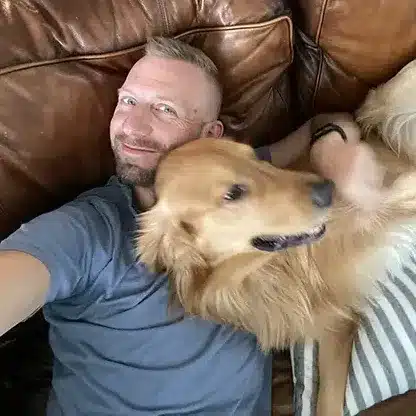Dog Bad Breath – Should You Be Worried?
Quick Guide
Considering all of the less-than-sanitary items dogs happily put in their mouths, many people don’t think twice about a dog’s bad breath. Once you’ve seen a dog root through a cat’s litter box or the neighbor’s trash, a whiff of icky breath doesn’t seems like much to worry about.
But before you shrug off those stinky kisses, you need to figure out the real cause behind them. Persistent bad breath is a symptom that should be taken seriously. It could be a sign of oral injury, dental disease, or other health issues. Once you’ve figured out what’s causing your dog’s bad breath, you can make it a thing of the past.
Dental Disease
Dental disease is the most common culprit when it comes to bad breath in dogs. Plaque and tartar on a dog’s teeth harbor lots of bacteria, which can be responsible for the bad smell coming from your dog’s mouth. Plaque, tartar, and bacteria all irritate the gums, causing gingivitis (inflammation of the gums). Over time, all of this can damage teeth and their surrounding structures, which makes it easier for more plaque and tartar to form. Left untreated, this damage worsens to the point where it may be irreversible. The earlier you catch signs of dental disease, the better chance you have of keeping your dog’s mouth healthy into old age.
The common signs of dental disease in dogs include:
- Bad breath
- Irritated, swollen, or bleeding gums
- Dropping food while chewing
- Wanting to chew only on one side of the mouth
- Rubbing at the mouth
- Nasal discharge and/or repetitive sneezing
- Discolored and/or loose teeth
Oral Injury or Foreign Objects
Many dogs are good at hiding their discomfort. If you don’t actually see your dog get hurt, it can take a while to figure out that something’s wrong. Sticks or bones can lacerate the gums, or they can become lodged in a dog’s mouth. Broken teeth can occur as a result of aggressive chewing or facial trauma. All of these injuries have a strong chance of becoming infected, especially if they go unnoticed for some time.
Many of the signs of oral injury are similar to those seen with dental disease:
- Bad breath
- Dropping food while chewing
- Facial swelling
- Rubbing at the mouth
- Yelping (especially when eating)
- Bloody saliva
- Sudden head-shyness
- Loss of interest in food and/or water
Diseases Outside of the Mouth
While diseases of the mouth are the most obvious culprit for causing bad breath, other health issues may be responsible as well. Diabetes, for example, can cause a dog to develop sweet or fruity breath. With diabetes, you’ll likely see other warnings, such as excessive thirst, weight loss, increased urination, and lethargy.
Increased thirst and urination are also seen in dogs with kidney disease, an illness which can cause the breath to smell like urine or ammonia. Dogs with kidney disease may also vomit and develop diarrhea or constipation.
Liver failure can also contribute to bad breath. Symptoms include vomiting, disorientation, loss of appetite, and gastrointestinal issues. It’s also often associated with a yellowing of the eyes, tongue, and/or gums.
If you notice any of the above symptoms, consult your veterinarian.
When You Don’t Need to Worry
If your dog receives a clean bill of health from your veterinarian but still has bad breath, know that other – less concerning – causes may be to blame. Keep an eye on what your dog gets into during the day (and night). If there’s a litter box in the house, restrict access to it. Some dogs have a knack for finding the stinkiest trash can or sneaking into the bathroom unobserved. If you must, confine your dog to his crate or a safe room when you can’t observe his behavior.
Puppies, cute as they might be, often have terrible breath (but since it’s associated with puppies, some people actually like it!). The teething process can make their breath smell metallic or fishy. Fortunately, this is a short-lived experience.
Don’t forget to take a look at the ingredients in your dog’s food. Some kinds, particularly those of a fish-flavored variety, can leave potent smells behind. If it’s a noticeable problem, you might want to consider switching to another formulation.
Prevention
Prevention is much simpler (and less expensive) than treatment, and when it comes to dental problems, you can take a very proactive role in prevention.
Daily, or at least every-other-day, tooth-brushing is the best way to keep your dog’s teeth and gums healthy. Use a veterinary-approved toothpaste. A soft toothbrush is ideal, but a rubber “finger brush” or a simple piece of cloth will also work.
If your dog is particularly resistant to having his or her teeth brushed, look into treats, food, and other products specifically designed for canine dental care. Offer appropriate chew toys that will do some of the plaque-removal work for you. With dogs who are opposed to having their teeth brushed, it is especially critical to have regularly scheduled oral exams.
Just like with people, brushing teeth at home is not a substitute for professional cleanings. Taking your dog in for regular dental checkups and physical exams will put you in the best position to catch and deal with any problems that do develop before they become severe.











